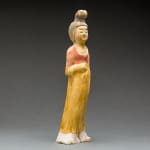Sui Glazed Sculpture of a Lady in Waiting, 581 CE - 618 CE
Painted Terracotta
height 26.4 cm
height 10 3/8 in
height 10 3/8 in
H.873
Despite its brief duration, lasting for the rule of only two emperors, the Sui Dynasty paved the way for the golden age attained during the T’ang Dynasty. Perhaps their most...
Despite its brief duration, lasting for the rule of only two emperors, the Sui Dynasty paved the way for the golden age attained during the T’ang Dynasty. Perhaps their most significant program was the construction of the Great Canal, a project that facilitated the movement of people and goods across great distances, leading to the reunification of China. However, the cost of the Canal bankrupted the empire and ultimately led to its dissolution. The rulers of the T’ang would capitalize on the infrastructure improvements of the Sui and establish one of the greatest empires in the history of China, following the footsteps of the Sui.
Secular sculpture of the Sui dynasty is represented by tomb figurines that are slim and unadorned, characterized by a yellowish crème glazed that would be elaborated upon in the Sancia-glazed ware of the T’ang Dynasty. These figurines, still bearing earthen residue, exemplify Sui tastes, as they were made specifically to accompany their lord in the afterlife. This stunning sculpture of a female attendant is a gorgeous example of Sui Dynasty sculpture. While her long-sleeved dressed have been covered in a vibrant yellow glaze, she wears a blouse on top of her dress that has been painted bright red. In addition, her facial features and hair have been highlighted in black paint, with red for her lips. Such women may represent wives, princesses, or attendants. Her beauty inspires us as we transport back in time to another era, over a thousand years ago, where this woman once danced or sang for us, or awaited our beck and call.
Secular sculpture of the Sui dynasty is represented by tomb figurines that are slim and unadorned, characterized by a yellowish crème glazed that would be elaborated upon in the Sancia-glazed ware of the T’ang Dynasty. These figurines, still bearing earthen residue, exemplify Sui tastes, as they were made specifically to accompany their lord in the afterlife. This stunning sculpture of a female attendant is a gorgeous example of Sui Dynasty sculpture. While her long-sleeved dressed have been covered in a vibrant yellow glaze, she wears a blouse on top of her dress that has been painted bright red. In addition, her facial features and hair have been highlighted in black paint, with red for her lips. Such women may represent wives, princesses, or attendants. Her beauty inspires us as we transport back in time to another era, over a thousand years ago, where this woman once danced or sang for us, or awaited our beck and call.



